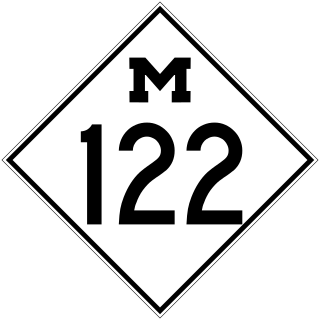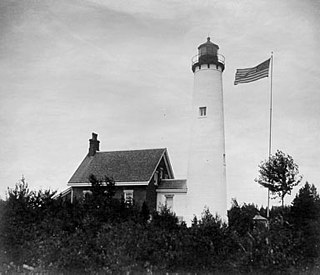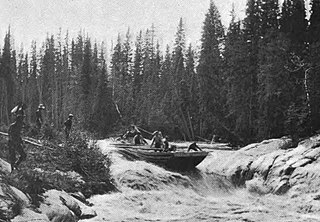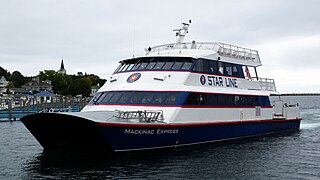
The Mackinac Bridge is a suspension bridge that connects the Upper and Lower peninsulas of the U.S. state of Michigan. It spans the Straits of Mackinac, a body of water connecting Lake Michigan and Lake Huron, two of the Great Lakes. Opened in 1957, the 26,372-foot-long bridge is the world's 27th-longest main span and is the longest suspension bridge between anchorages in the Western Hemisphere. The Mackinac Bridge is part of Interstate 75 (I-75) and carries the Lake Michigan and Huron components of the Great Lakes Circle Tour across the straits; it is also a segment of the U.S. North Country National Scenic Trail. The bridge connects the city of St. Ignace to the north with the village of Mackinaw City to the south.

St. Ignace is a city in the U.S. state of Michigan and the county seat of Mackinac County. The city had a population of 2,306 at the 2020 census. St. Ignace Township is located just to the north of the city, but the two are administered autonomously.

Mackinaw City is a village at the northernmost point of the Lower Peninsula of Michigan, United States. Divided between Cheboygan and Emmet counties, Mackinaw City is located at the southern end of the Mackinac Bridge, which carries Interstate 75 over the Straits of Mackinac to St. Ignace, in the Upper Peninsula. Mackinaw City and St. Ignace also serve as access points for ferries to and from Mackinac Island. For these reasons, Mackinaw City is considered one of Michigan's most popular tourist attractions.

The Straits of Mackinac are the short waterways between the U.S. state of Michigan's Upper and Lower Peninsulas, traversed by the Mackinac Bridge. The main strait is 3+1⁄2 miles wide with a maximum depth of 295 feet, and connects the Great Lakes of Lake Michigan and Lake Huron. Given the large size and configuration of the straits, hydrologically, the two connected lakes are one body of water, studied as Lake Michigan–Huron. Historically, the native Odawa people called the region around the Straits Michilimackinac.

M-122 was a state trunkline highway in the US state of Michigan entirely in the city of St. Ignace. The highway connected US Highway 2 (US 2) to the State Highway Ferry Dock used before the Mackinac Bridge was built. It was retired and the road returned to local control in 1957.

The buildings of the St Helena Light complex are the sole surviving structures on St. Helena Island, in Mackinac County in the U.S. state of Michigan. The lighthouse on the St. Helena Island's southeastern point was built in 1872-1873 and went into operation in September 1873. It became one of a series of lighthouses that guided vessels through the Straits of Mackinac, past a dangerous shoal that extends from the island.

The Mackinaw boat is a loose, non-standardized term for a light, open sailboat or rowboat used in the interior of North America during the fur trading era. Within this term two different Mackinaw boats evolved: one for use on the upper Great Lakes, and the other for use on the upper Missouri River and its principal tributaries.

Chief Wawatam was a coal-fired steel ship that was based, for most of its working life, in St. Ignace, Michigan. The vessel was named after a distinguished Ojibwa chief of the 1760s. In initial revenue service, the Chief Wawatam served as a train ferry, passenger ferry and icebreaker that operated year-round at the Straits of Mackinac between St. Ignace and Mackinaw City, Michigan. During the winter months, it sometimes took many hours to cross the five-mile-wide Straits, and Chief Wawatam was fitted with complete passenger hospitality spaces.

Vacationland was an automobile ferry that operated in Michigan's Straits of Mackinac between Mackinaw City and St. Ignace from 1952 to 1957, when the Mackinac Bridge was completed.

Arnold Transit Company was a ferry boat company serving Mackinac Island in Michigan for 140 years. In late 2016 Arnold Line's Assets including the boats, docks along with its name were purchased by Star Line Ferry, who continues to operate it today.

The history of commercial passenger shipping on the Great Lakes is long but uneven. It reached its zenith between the mid-19th century and the 1950s. As early as 1844, palace steamers carried passengers and cargo around the Great Lakes. By 1900, fleets of relatively luxurious passenger steamers plied the waters of the lower lakes, especially the major industrial centres of Chicago, Milwaukee, Detroit, Cleveland, Buffalo, and Toronto.
The Mackinac Transportation Company was a train ferry service that shuttled railroad cars across the Straits of Mackinac from 1881 until 1984. It was best known as the owner and operator, from 1911 until 1984, of the SS Chief Wawatam, an icebreaking train ferry.

The lighthouse at Fourteen Foot Shoal was named to note that the lake is only 14 feet (4.3 m) deep at this point, which is a hazard to navigation, ships and mariners.

Bois Blanc Light can refer to one of five lighthouses erected on Bois Blanc Island, Michigan, in Lake Huron. Two of the lighthouses are currently standing. The lighthouse and surrounding property are privately owned and closed to the public.

The ruined lighthouse at Waugoshance protects boats from a shoal area at the northern end of Lake Michigan. The lighthouse is located in Emmet County, Michigan, United States, and in U.S. Coast Guard District No. 9. It is approximately 15 miles (24 km) west of Mackinaw City. Due to erosion and deterioration, the lighthouse is deteriorating and critically endangered, and likely to fall into the lake in the near future.

The North Central State Trail is a 62-mile (100 km) recreational rail trail serving a section of the northern quarter of the Lower Peninsula of the U.S. state of Michigan. Following a route generally parallel to Interstate 75, the trail goes northward from the Michigan town of Gaylord to the top of the Lower Peninsula at Mackinaw City and connects to the North Western State Trail. It serves the towns of Vanderbilt, Indian River, and Cheboygan which connects to the North Eastern State Trail.

Mackinac Island Ferry Company is a ferry boat company serving Mackinac Island in Michigan. The company has a dock at Mackinaw City and two at St. Ignace.

Due to its unique geography, being made of two peninsulas surrounded by the Great Lakes, Michigan has depended on many ferries for connections to transport people, vehicles and trade. The most famous modern ferries are those which carry people and goods across the Straits of Mackinac to the car-free Mackinac Island but before the Mackinac Bridge was built, large numbers of ferries carried people and cars between the two peninsulas. Other ferries continue to provide transportation to small islands and across the Detroit River to Canada. Ferries once provided transport to island parks for city dwellers. The state's only national park, Isle Royale cannot be reached by road and is normally accessed by ferry. The largest ferries in Michigan are the car ferries which cross Lake Michigan to Wisconsin. One of these, the SS Badger is one of the last remaining coal steamers on the Great Lakes and serves as a section of US Highway 10 (US 10). The Badger is also the largest ferry in Michigan, capable of carrying 600 passengers and 180 autos.

Wawatam Lighthouse is an automated, modern lighthouse that guards the harbor of St. Ignace, Michigan, in the Straits of Mackinac. Originally completely nonfunctional, it was erected in 1998 by the Michigan Department of Transportation (MDOT) near Monroe, Michigan as an iconic roadside attraction at a welcome center that greeted northbound drivers on Interstate 75 (I-75). After serving in this capacity for six years, the structure was threatened in 2004 when MDOT decided to rebuild the welcome center and demolish the tower.

East Moran Bay is a small, historic harbor in the Straits of Mackinac adjacent to the city of St. Ignace in the U.S. state of Michigan. The harbor is used as a commercial port for Star Line Ferry and Shepler's Ferry ferry boats from St. Ignace to Mackinac Island, a tourist center of the Straits of Mackinac. The bay and its harbor are guarded by the Wawatam Lighthouse.




















